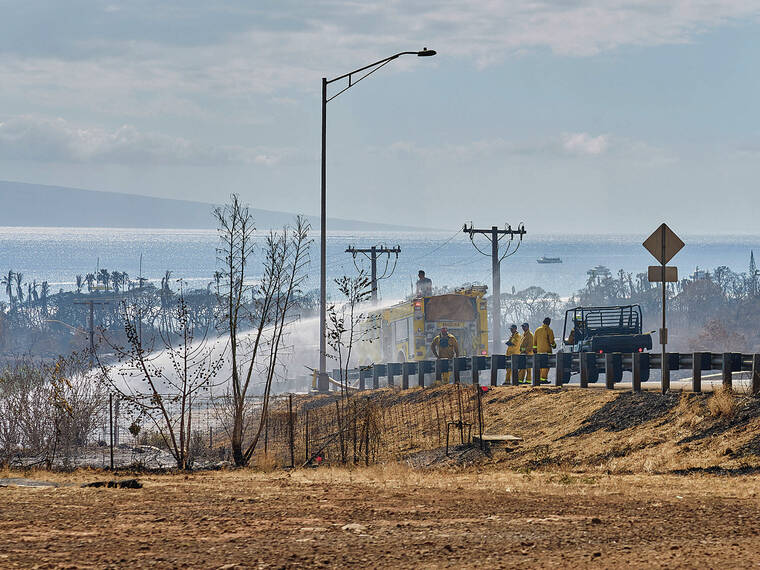
Maui firefighters who responded to the August 2023 Maui wildfires had the highest levels of “forever chemicals” known as PFAS in their bloodstream when compared with other first responders a month later. PFAS, or per-fluoroalkyl and poly-fluoroalkyl substances, are synthetic chemicals used in many industry and consumer products, including firefighting foams that are associated with cancer and other adverse health effects. They are called “forever chemicals” because they do not break down easily.
A recent report by the U.S. Centers for Disease Control and Prevention — the first known to focus specifically on Maui County first responders — shared this finding, noting that the Aug.

8, 2023, wildfires destroyed thousands of structures, vehicles and parcels of land, resulting in 102 deaths. Among firefighters the median sum serum concentrations of seven types of PFAS was at 7.0 micrograms per liter, higher than other Maui County participants.
For other work groups, including police and lifeguards, the median sum serum concentrations ranged from 5.7 to 6.9 micrograms per liter.
The study also found PFAS concentrations to be highest among firefighters who had been working for 30 years or more. At Maui County’s request, researchers from CDC’s National Institute for Occupational Safety and Health evaluated the exposures of first responders to various chemicals following the wildfires. NIOSH invited all Maui County employees involved in the first five days of wildfire response to participate, which required providing blood and urine specimens and filling out questionnaires.
More than 250 participated, including firefighters, police officers, ocean safety lifeguards and public works employees involved in fighting and extinguishing fires, evacuation, water rescue and urban search and rescue operations. The NIOSH team found the highest concentrations of perfluorohexane sulfonic acid, or PFHxS — one type of PFAS — among firefighters. In fact, one firefighter had about 2.
5 times the recommended threshold level of PFHxS in his blood sample and was advised to seek additional screening and follow-up care from a health care provider. “This is not a surprising result,” said author Catherine Beaucham, a CDC NIOSH epidemiologist, in an email. “The elevated level of PFHxS in the Maui firefighters was consistent with other studies that have shown that firefighters have elevated serum concentrations of some PFAS, including PFHxS, compared with the general population and other working populations.
” Hazards of the job The findings are not entirely surprising, either, to Bobby Lee, president of the Hawaii Fire Fighters Association, Local 1463, which represents more than 2,000 active-duty and 1,000 retired firefighters statewide. These health risks are part of the many hazards of the job, given that the World Health Organization has, after all, classified occupational exposure as a firefighter as a “group 1 carcinogen.” The WHO’s International Agency for Research on Cancer agency found that “occupational exposures as a firefighter causes cancer,” particularly mesothelioma and cancer of the bladder.
“Along with the normal hazards that come with the job, we’re finding out our protective clothing contains contaminants like PFAS, which the manufacturers are trying to address,” he said. “And then when you have a tragic incident like what happened in Lahaina, it’s in an old neighborhood that has old building materials that have been banned for decades. When they respond to a situation like that, of course, the high contaminants become a very serious concern for our members.
” Lee said he supported efforts to monitor the health of firefighter members, and the union is advocating for more workers compensation protection for diseases such as cancer. Senate Bill 828 seeks to expand workers’ compensation benefits for firefighters to cover a wide range of illnesses, including mesothelioma of the respiratory system; cancer of the buccal cavity, colon, pharynx, and thyroid; and malignant melanoma, among others, unless the employer can prove that the cancer was not associated with the firefighting duties. Senate committees acknowledged that “firefighters perform an essential duty in the state for the sake of public safety” and are often exposed to carcinogenic agents from fire combustion products linked to an increased risk of cancer.
The bill is supported by the Hawaii Fire Fighters Association, Hawaii State Fire Council, Hawaii County Fire Department and state Department of Labor and Industrial Relations. Lee said the hazards for first responders responding to the Maui wildfires has been equated to the Sept. 11, 2011, attack on the World Trade Center in New York.
Dan Moynihan, who was a firefighter at ground zero on that day, teamed up with the American Lung Association in Hawaii to urge first responders to wear proper masks — N95 respirators — to protect themselves in the aftermath of the Maui wildfires. Moynihan, now retired and a part-time Oahu resident, continues to suffer from chronic obstructive pulmonary disease, chronic migraines and sinus issues, among other health challenges. He has seen friends and colleagues suffer from cancer, and says 69 cancers have been associated with exposure to the World Trade Center disaster.
The issue of PFAS in firefighting gear has been a national issue for decades, he said, with numerous studies conducted, and he is still waiting for manufacturers to make changes. “Unfortunately, not everyone has learned what to do about PFAS,” he said. “It’s a preventable hazard.
” Further study needed A total of 258 Maui County employees participated in the study, including 178 firefighters, 39 police officers, 19 ocean safety officers or lifeguards and 22 public works employees. Researchers said sources of PFAS exposure for firefighters include fire effluents and dust, contaminated gear and equipment, and textiles used in protective clothing worn by firefighters. Previous studies have shown firefighters have elevated concentrations of PFAS in their blood compared with the general and other working populations.
Since there were no baseline measurements for comparison, researchers said it was unclear what role the 2023 Maui wildfires played in the higher PFAS levels, as there could have been other contributing sources. The reported use of respiratory protection varied widely, and was commonly used by about 40% of firefighters. “Inconsistent use of respirators and other personal protective equipment could increase the risk for exposure to PFAS and other chemicals,” the study said.
Authors concluded that further research is needed to better understand the risk among those responding to wildfire disasters. Most Maui firefighters, however, did not exceed a recommended threshold requiring additional medical screenings. Prior to the CDC report, a July NIOSH report listed recommendations for limiting PFAS exposures, including the use of alternative firefighting foams, personal protective equipment and decontamination of gear.
Maui firefighters were also offered the opportunity to enroll in the National Firefighter Registry for Cancer, which conducts long-term tracking of cancer outcomes. The data from Maui could be combined with others to better help understand cancer in firefighters. The report noted the U.
S. is experiencing higher fire activity than in past years, including more destructive urban-rural interface fires, meaning that more first responders and communities are potentially exposed to hazardous chemicals. What are PFAS? >> PFAS is short for per- and poly-fluoroalkyl substances, a class of more than 15,000 synthetic chemicals that help materials repel water, grease and stains.
>> Common items with PFAS include food packaging; paints; stain-resistant carpets, rugs and furniture; nonstick cookware; water-repellent jackets; and firefighting foam. >> Studies have shown PFAS do not easily break down (thus, the nickname “forever chemicals”) and can persist in bodies and the environment for decades. >> Nearly all people in the U.
S. have PFAS in their blood. >> A growing body of scientific research links PFAS exposure with adverse health effects, including kidney and testicular cancer, increases in cholesterol levels, endocrine disruption and immune system suppression.
Source: Earthjustice, CDC, NIOSH CDC findings Maui wildfire first responders >> A total of 258 Maui County employees tested, including 178 firefighters, 39 Maui Police Department employees, 19 ocean safety officers, 22 public works employees. >> Testing was conducted in September 2023, about a month after the Maui wildfires. >> Median age of participants was 40, 94% were male, 46% identified as part Native Hawaiian or other Pacific Islander.
>> Among firefighters the median sum serum concentrations of seven types of PFAS was at 7.0 micrograms per liter, which was higher than other Maui County participants. >> In general, higher median sum concentrations of PFAS were detected among firefighters with longer job tenure (30 or more years).
Source: CDC Morbidity and Mortality Weekly Report, February 2025.















